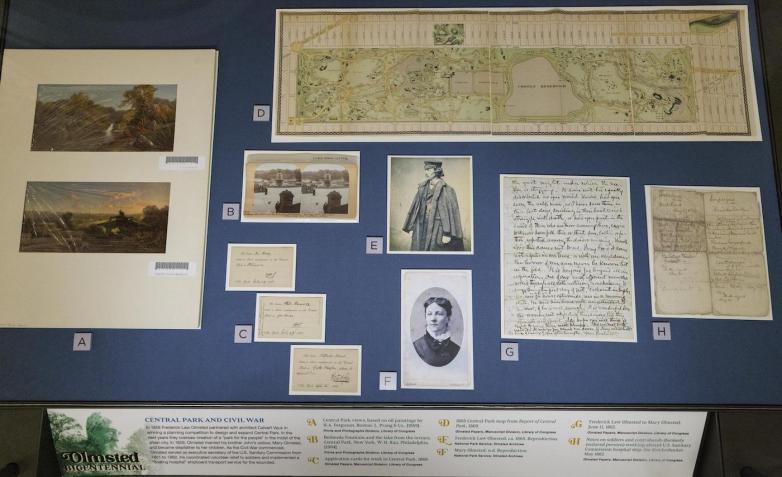Exhibit Marks 200 Years of Landscape Architect Frederick Law Olmsted

Items on view detailing Frederick Law Olmsted's role in designing Central Park and his role in the Civil War.
Washington, DC — The Library of Congress is marking the bicentennial of the birth of Frederick Law Olmsted — the landscape architect and writer who designed the U.S. Capitol grounds and many public parks and university campuses — with a display on view through June 4.
The “Olmsted Bicentennial” exhibition is on view in the Library’s Thomas Jefferson Building in the Great Hall East and West galleries. This five-case exhibit charts Olmsted’s life experience, philosophy and legacy in promoting the benefits of access to the natural world, public health, parks for recreation and revitalization, and democratically shared public spaces.
The Library holds Olmsted’s collection, documenting his professional and personal life, along with the closely related Olmsted Associates Records from the landscape architecture firm operated by Olmsted’s sons. The Olmsted collection has been digitized and is available here, and the Olmsted Associates Records are available here.
The exhibit features select items from the Library’s Manuscript Division, General Collections and Prints & Photographs Division in combination with reproductions of drawings and photographs from the National Park Service, including the Olmsted Archive at the Frederick Law Olmsted Historic Site in Brookline, Massachusetts.
Some highlights include:
• Olmsted’s draft autobiography.
• Letters to his wife, Mary, about the Civil War and the Mariposa Grove of Giant Sequoias at Yosemite National Park.
• A map of New York’s Central Park.
• Design materials for the U.S. Capitol grounds.
• Photographs then and now.
The exhibit follows Olmsted’s life. He gained experience growing up in the woodlands of the Connecticut Valley and on trips in New England and New York, including to Niagara Falls and Lake George. He widened his observations through travels as a young man to England, Europe and China. As a journalist and travel writer in the fraught decade before the Civil War, he published observations of park and garden systems internationally and wrote of the economy and sociology of the slaveholding American South and Texas.
His breakthrough as an innovative planner of public parks came just before the war, when he partnered between 1857 and 1861 with architect Calvert Vaux to implement their award-winning design for Central Park in New York City. After the war began, Olmsted served as general secretary for the U.S. Sanitary Commission and helped devise a system of “floating hospital” ships to transport the ill and wounded of the Union Army.
After the war, he proposed projects located in all regions of the country and parts of Canada, emerging as the foremost spokesperson for the public parks movement. His treatises on the planning, access and use of public parks influenced the creation of the Emerald Necklace system of greenways in Boston and the formation of Yosemite National Park by an Act of Congress in 1890. The Olmsted legacy reached into Canada with Mount Royal Park in Montreal, and was manifested at Niagara Falls, in the Stanford and University of California, Berkeley, campuses in California and Gallaudet University in the District of Columbia.
He was a mentor to his son, Frederick Law Olmsted, Jr., and step-son, John Charles Olmsted. He also mentored a stream of young associates, most affiliated with Arnold Arboretum and Harvard University.After his death in 1903, the work of the Olmsted firm was carried on into the next half-century from his Fairsted home and headquarters in Brookline.Associates of the firm included Edward Clark Whiting, who was responsible for much of the firm’s planning for Rock Creek Park in Washington, D.C.
The Library joins the American Society of Landscape Architects, the Cultural Landscape Foundation, the National Association for Olmsted Parks, the National Park Service, local Olmsted park conservancies and many other institutions and organizations across the nation in recognizing the ongoing impact and history of Olmsted’s theories of public parks and two generations of Olmsted family landscape designs.
Leading up to the bicentennial of Olmsted’s birth on April 26, the Library’s By the People crowdsourcing transcription program hosted a weekly series of special “By Design: Frederick Law Olmsted and Associates” campaign challenges. Based on the subject file in the Olmsted papers collection, the challenges gave online volunteers a chance to get up close and personal with Olmsted. The volunteers transcribed select printed and handwritten materials from his papers or items from various geographical regions that were the focus of Olmsted’s many projects and proposals.















